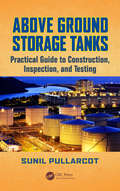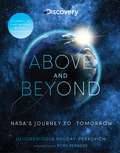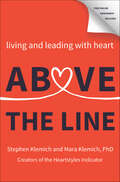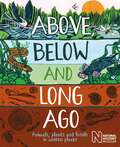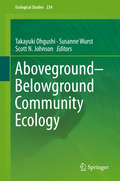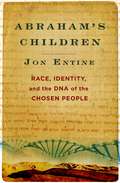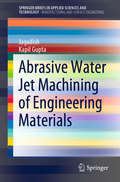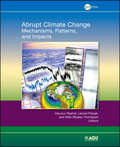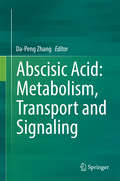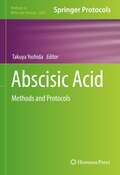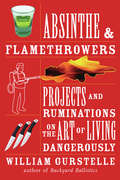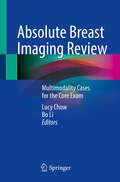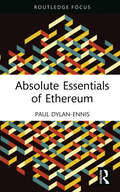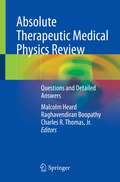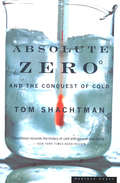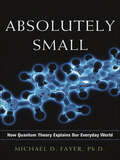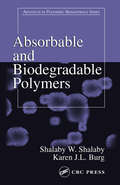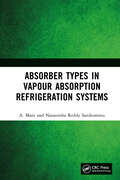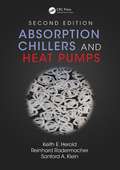- Table View
- List View
Above Ground Storage Tanks: Practical Guide to Construction, Inspection, and Testing
by Sunil PullarcotCovers All Site Activities after DesignAbove Ground Storage Tanks: Practical Guide to Construction, Inspection, and Testing is an ideal guide for engineers involved in the mechanical construction of above ground storage tanks. This text details the construction of storage tanks in accordance with the American Petroleum Institute requirements for AP
Above and Beyond: NASA's Journey to Tomorrow
by Discovery Olugbemisola Rhuday-PerkovichSince NASA was established in 1958, it has landed rovers on distant planets and launched telescopes deep into space—all so that we can look back to the beginning of time. <P><P> Through stunning images provided by NASA and fascinating profiles and sidebars of lesser known contributors to the NASA program, young space fans will learn how NASA started, how it faced challenges along the way, how much it has achieved, and how it will continue to move forward in the future. <P> NASA’s boundless curiosity and urge to explore lies at the heart of the human adventure. NASA rises to the urgent challenges we face, using its massive reach and expertise to find answers to vital questions like: How can we learn to live in a more extreme natural environment? <P> Inspired by Rory Kennedy’s documentary of the same name (airing 10/2018), Above and Beyond aims to leave audiences hopeful and inspired about the future of our planet—and convinced that NASA is essential to our continued survival as we mark its important anniversaries and dream of new discoveries to come.
Above the Line: Living and Leading with Heart
by Stephen Klemich Mara KlemichA leadership consultant and neuropsychologist identify the universal habits of the heart and mind—the keys to unlocking our true potential, creating our best selves and eliminating behavior patterns that hold us back. Why is it so hard for leaders to coach employees who are struggling? Why do we repeat the same mistakes and negative behaviors? Common wisdom says you always have a choice in how you react or respond. But, as corporate consultant Stephen Klemich and clinical psychologist Mara Klemich contend, until you recognize why you make choices, and how the heart and the brain work together to shape your behavior, you can’t change long-ingrained patterns and discover your best self.The Klemichs have developed a model backed by extensive research and data, and paired it with character-led personal development, to help you answer the "Why?" and eliminate behavior that is “below the line.” In Above the Line, they argue that that the quality of your life flows from the attitudes of your heart. Offering wise, compassionate, and practical advice, this book explores the deep, fundamental drivers of human behavior that exist within your heart—the seat of your character. It reveals that all of these behaviors can be explained by four principles—humility, love, pride, and fear—which influence every facet of your life, for better or for worse.We are all designed for greatness, but so often our best self is pitted against our worst. The pressures of life are pulling our character below the line while our authentic self is drawing us to live above the line. When you fully understand that the four principles are at the root of your behavior, you can begin the journey to become your best self and navigate life more effectively and successfully. Filled with proven strategies, Above the Line will create lasting changes in your behavior and improve your life personally and professionally—so you can make a positive impact on the world around you.
Above, Below and Long Ago: Animals, plants and fossils in unseen places
by Michael BrightProduced with the Natural History Museum, this book brings you closer to the wildlife that's hard to reach - to the animals and plants in the skies, deep underwater, on clifftops, in caves and underground. Find out how plants and animals adapted to these environments and about wildlife from long ago. Filled with stylish linocut prints of wildlife, this is a book you will admire for its beauty as well as for the fascinating information inside.Discover the snow leopard as it hunts mountain goats and sheep, the ghostly pale, eel-shaped olm and a mysterious orchid that only blooms underground.With gorgeous linocut prints, this beautiful book reveals the textures and patterns of the natural world.
Aboveground–Belowground Community Ecology (Ecological Studies #234)
by Scott N. Johnson Takayuki Ohgushi Susanne WurstResearchers now recognize that above- and belowground communities are indirectly linked to one another, often by plant-mediated mechanisms. To date, however, there has been no single multi-authored edited volume on the subject. This book remedies that gap, and offers state-of-the art insights into basic and applied research on aboveground-belowground interactions and their functional consequences. Drawing on a diverse pool of global expertise, the authors present diverse approaches that span a range of scales and levels of complexity.The respective chapters provide in-depth information on the current state of research, and outline future prospects in the field of aboveground-belowground community ecology. In particular, the book’s goal is to expand readers’ knowledge of the evolutionary, community and ecosystem consequences of aboveground-belowground interactions, making it essential reading for all biologists, graduate students and advanced undergraduates working in this rapidly expanding field. It touches on multiple research fields including ecology, botany, zoology, entomology, microbiology and the related applied areas of biodiversity management and conservation.
Abraham Lincoln's DNA and Other Adventures in Genetics
by Philip R. ReillyTwenty-four true, wide-ranging tales of crime, history, human behavior, illness, and ethics, told from the personal perspective of the author, an eminent physician-lawyer who uses the stories to illustrate the principles of human genetics and to discuss the broader issues.
Abraham's Children: Race, Identity, and the DNA of the Chosen People
by Jon EntineCould our sense of who we are really turn on a sliver of DNA? In our multiethnic world, questions of individual identity are becoming increasingly unclear. Now in ABRAHAM'S CHILDREN bestselling author Jon Entine vividly brings to life the profound human implications of the Age of Genetics while illuminating one of today's most controversial topics: the connection between genetics and who we are, and specifically the question "Who is a Jew?" Entine weaves a fascinating narrative, using breakthroughs in genetic genealogy to reconstruct the Jewish biblical tradition of the chosen people and the hereditary Israelite priestly caste of Cohanim. Synagogues in the mountains of India and China and Catholic churches with a Jewish identity in New Mexico and Colorado provide different patterns of connection within the tangled history of the Jewish diaspora. Legendary accounts of the Hebrew lineage of Ethiopian tribesmen, the building of Africa 's Great Zimbabwe fortress, and even the so-called Lost Tribes are reexamined in light of advanced DNA technology. Entine also reveals the shared ancestry of Israelites and Christians. As people from across the world discover their Israelite roots, their riveting stories unveil exciting new approaches to defining one's identity. Not least, Entine addresses possible connections between DNA and Jewish intelligence and the controversial notion that Jews are a "race apart." ABRAHAM'S CHILDREN is a compelling reinterpretation of biblical history and a challenging and exciting illustration of the promise and power of genetic research.
Abrasive Water Jet Machining of Engineering Materials (SpringerBriefs in Applied Sciences and Technology)
by Kapil Gupta JagadishThis book presents insights in green techniques used in conventional and advanced machining. It consists of various experimental case studies conducted by the authors on green machining of difficult-to-machine materials, polymer and ceramic materials. Effects of green techniques / processes on machining properties like material removal rate, surface quality, geometric accuracy, productivity, and environment while machining various materials are reported.
Abrir en caso de apocalipsis: Guía rápida para reconstruir la civilización
by Lewis Dartnell"Una mirada fascinante a los principios básicos de las principales tecnologías que sostienen la sociedad contemporánea" Wall Street Jounal Una pandemia incontrolable, el impacto de un meteorito, o quizá una guerra nuclear; por el motivo que sea, el mundo que conocemos ha desaparecido y los escasos supervivientes deben comenzar de cero. ¿Cuáles son los conocimientos fundamentales necesarios para reconstruir nuestra civilización? Tras recoger lo poco lo poco que queda, ¿cómo se puede empezar a producir lo esencial? ¿Cómo cultivar alimentos, generar electricidad, preparar medicinas o extraer metal de las rocas? ¿Se puede evitar una nueva edad oscura y aprovechar los atajos para conseguir de nuevo el desarrollo? La vida en las sociedades contemporáneas nos han desconectado de los procesos básicos que nos sostienen, así como de las elegantes premisas científicas que permiten aprender las cosas por uno mismo. "Abrir en caso de apocalipsis" es un viaje de exploración, un libro que explica todo lo que hay que saber acerca de todo lo que nos rodea. Una guía rápida para reiniciar la civilización que transformará nuestra comprensión del mundo, y nos ayudará cuando este ya no exista.
Abrupt Climate Change
by Leonid Polyak Ellen Mosley-Thompson Harunur RashidPublished by the American Geophysical Union as part of the Geophysical Monograph Series, Volume 193.Abrupt Climate Change: Mechanisms, Patterns, and Impacts brings together a diverse group of paleoproxy records such as ice cores, marine sediments, terrestrial (lakes and speleothems) archives, and coupled ocean-atmosphere climate models to document recent advances in understanding the mechanisms of abrupt climate changes. Since the discovery of the Dansgaard-Oeschger events in Greenland ice cores and the subsequent discovery of their contemporary events in the marine sediments of the North Atlantic, the search for these abrupt, millennial-scale events across the globe has intensified, and as a result, the number of paleoclimatic records chronicling such events has increased. The volume highlights include discussions of records of past climate variability, meridional overturning circulation, land-ocean-atmosphere interactions, feedbacks in the climate system, and global temperature anomalies. Abrupt Climate Change will be of interest to students, researchers, academics, and policy makers who are concerned about abrupt climate change and its potential impact on society.
Abschied vom Eis: Ein Weckruf aus der Arktis
by Peter WadhamsDas Meereis der Polargebiete ist nicht nur wunderschön, es reguliert auch die Temperatur der Erde. Doch es zieht sich zurück – und zwar schnell! Dabei laufen komplexe Rückkopplungen ab, die das Potenzial haben, den Klimawandel zu beschleunigen und zu verstärken. Der britische Polarforscher Peter Wadhams ist einer der international führenden Meereisexperten. Er greift auf seine fast lebenslange Forschung in der Arktis zurück, um zu erklären, was gerade passiert, was das für unsere Zukunft bedeutet – und was wir tun können und müssen.Der AutorPeter Wadhams ist einer der weltweit erfahrensten Polar- und Meereisforscher. Er war von 1987–92 Direktor des Scott Polar Institute in Cambridge und dort auch von 1992–2015 Professor für Physik der Ozeane. Er war an mehr als 50 Expeditionen in beide Polarregionen beteiligt – in Forschungscamps, auf Eisbrechern, von Flugzeugen aus, und sogar in Unterseebooten. Er wurde ausgezeichnet mit dem W. S. Bruce-Preis der Royal Society of Edinburgh (1977), der UK Polar Medal (1987) und dem Italgas-Preis für Umweltwissenschaften (1990). Er ist Fellow der Royal Geographical Society und Mitglied der Finnischen Akademie.
Abscisic Acid: Metabolism, Transport And Signaling
by Da-Peng ZhangThis book provides a comprehensive review of all aspects of the molecular and cell biology of abscisic acid (ABA) metabolism, transport and signal transduction, covering our current understanding of ABA as well as research trends. The agricultural significance of ABA metabolism, transport and signal transduction is also discussed. The phytohormone ABA regulates many aspects of plant development and plays a central role in plant adaptation to environmental stresses. Over the past few decades, considerable advances have been made in the study of ABA metabolism, transport and signal transduction, greatly deepening our understanding of the underlying mechanisms of ABA function at the molecular, cell and whole-plant level and helping us improve crops' environmental tolerance. This book provides a valuable resource for researchers and advanced students interested in plant biology and agriculture.
Abscisic Acid: Methods and Protocols (Methods in Molecular Biology #2462)
by Takuya YoshidaThis volume presents an all-inclusive overview of molecular biological methods to study ABA signaling transport, and metabolism in several plant species. The chapters in this book cover topics such as biochemical and molecular biological characterization of ABA receptors; assay systems for ABA transporters; quantification and visualization of ABA levels; and comprehensive omics approaches. Written in the highly successful Methods in Molecular Biology series format, chapters include introductions to their respective topics, lists of the necessary materials and reagents, step-by-step, readily reproducible laboratory protocols, and tips on troubleshooting and avoiding known pitfalls. Cutting-edge and thorough, Abscisic Acid: Methods and Protocols is a valuable resource for scientists and researchers who are interested in learning more about this developing field.
Absence of Mind: The Dispelling of Inwardness from the Modern Myth of the Self
by Marilynne RobinsonEssays from the lectures delivered at Yale University, the Dwight Harrington Terry Foundation. Includes bibliographical references.
Absence of Mind: The Dispelling of Inwardness from the Modern Myth of the Self
by Marilynne RobinsonIn this ambitious book, acclaimed writer Marilynne Robinson applies her astute intellect to some of the most vexing topics in the history of human thought--science, religion, and consciousness. Crafted with the same care and insight as her award-winning novels, Absence of Mind challenges postmodern atheists who crusade against religion under the banner of science. In Robinson's view, scientific reasoning does not denote a sense of logical infallibility, as thinkers like Richard Dawkins might suggest. Instead, in its purest form, science represents a search for answers. It engages the problem of knowledge, an aspect of the mystery of consciousness, rather than providing a simple and final model of reality. By defending the importance of individual reflection, Robinson celebrates the power and variety of human consciousness in the tradition of William James. She explores the nature of subjectivity and considers the culture in which Sigmund Freud was situated and its influence on his model of self and civilization. Through keen interpretations of language, emotion, science, and poetry, Absence of Mind restores human consciousness to its central place in the religion-science debate.
Absinthe & Flamethrowers: Projects and Ruminations on the Art of Living Dangerously
by William GurstelleWritten for reasonable risk takers and suburban dads who want to add more excitement to their lives, this daring combination of science, history, and DIY projects explains why danger is good for you and details the art of living dangerously. All of the projects--from throwing knives, drinking absinthe, and eating fugu to cracking a bull whip, learning baritsu, and building a flamethrower--have short learning curves; are human-focused, as opposed to technology-centric; are affordable; and demonstrate true but reasonable risk. The guide maintains that risk takers are more successful, more interesting individuals who lead more fulfilling lives. What would the world be like if Thomas Edison retired after 30 years working for the railroad, it asks, instead of getting fired for blowing up a rail car with one of his experiments? Though the manual doesn't advocate getting fired, it does reveal that making black powder is pure excitement. Unlike watching an action movie or playing a video game, real, edgy life experience changes a person. Each potentially life-altering project includes step-by-step directions and illustrations along with sidebar tips from experts in the field.
Absolute Breast Imaging Review: Multimodality Cases for the Core Exam
by Bo Li Lucy ChowThis book presents over 500 breast imaging questions with detailed answers to prepare readers for the Radiology Core Exam. Radiology residents looking for preparation materials to use for the Core Exam are often frustrated with the lack of resources available. This book addresses that lack by providing an informative and invaluable high-yield breast imaging case review book for board review and lifelong learning purposes. Editors and authors have collected numerous high quality breast imaging cases that directly align with each diagnosis the Core Exam has included in their study guide. Cases include modalities from mammogram, ultrasound, and MRI. High quality images are included for each case. The book is structured to follow the layout and topics of the ABR Study Guide, making all material boards-relevant. Within each section, cases are presented with boards-style multiple choice questions and detailed explanations, giving the reader over 500 breast imaging questions to learn from. Cases will include diagnosis, etiology, imaging characteristics, and management. Additional topics related to boards preparation and clinical practice are also addressed, including indications for screening, regulations, physics, and quality/safety. This is an ideal guide for radiology residents preparing for the breast imaging portion of their Radiology Core Examination, and for continued practice and learning for practicing radiologists.
Absolute Essentials of Ethereum (Absolute Essentials of Business and Economics)
by Paul Dylan-EnnisAbsolute Essentials of Ethereum is a concise textbook which guides the reader through the fascinating world of the emerging Ethereum ecosystem, from the basics of how its blockchain works to cutting-edge applications.Written by an experienced educator, each chapter is designed to progress potential students from class to class. Technical concepts are clearly explained for those new to the topic and readers are supported with definitions and summaries in each chapter. Real-life case studies situate the overviews in a contemporary context. Topics covered include the Ethereum Execution and Consensus layers, Ethereum governance and community, Decentralised Autonomous Organisations (DAOs), Decentralised Finance (DeFi), Non-Fungible Tokens (NFTs) and Layer 2.This book is the ideal text to support undergraduate and postgraduate courses on blockchain technologies, cryptocurrencies, Web3 and fintech, as well as for those who want to know how Ethereum really works.
Absolute Therapeutic Medical Physics Review: Questions and Detailed Answers
by Charles R. Thomas Malcolm Heard Raghavendiran BoopathyThis book is a comprehensive study guide for the therapeutic medical physicist pursuing initial board certification and those participating in continuing education. Medical physics is an evolving field as a result of rapidly developing technology and the focus on evidence-based care in radiation oncology. Recently, the certification body has mandated an online question and answer system to allow practicing physicist to receive continuing education credits. The questions are designed to test the walking around knowledge of the clinical physicist. Many physicists specialize in specific treatment modalities, thus limiting their exposure to other areas of clinical physics. This handbook allows these physicists to stay up-to-date and satisfy the requirements of the certification body. The text is divided into 2 main sections: Questions & Detailed Answers. Question chapters are divided by the ABR content guide and are composed of 15-35 questions. Questions are primarily multiple choice in nature with 4-5 possible answers, but there are also matching questions. Questions review the scope of medical physics, spanning from medical physics theories to day-to-day applications in clinic. The questions and detailed answers will be set in such a way to address most relevant and commonly tested topics of dosimetry, treatment machine, treatment planning, protection, radiobiology, radiation safety and professionalism and ethics. The questions will most closely fit to what is done in clinical practice. Detailed answers not only explain the correct answer, but also discuss the erroneous remaining answers with the appropriate citation of the most recent protocols, guidelines, publications and task group recommendations. This is an ideal study guide for therapeutic medical physicists in training and in practice, who need to pass a written board examination or prepare themselves for their continuing education requirements.
Absolute Zero and the Conquest of Cold
by Tom Shachtman&“A lovely, fascinating book, which brings science to life.&” —Alan Lightman Combining science, history, and adventure, Tom Shachtman &“holds the reader&’s attention with the skill of a novelist&” as he chronicles the story of humans&’ four-centuries-long quest to master the secrets of cold (Scientific American). &“A disarming portrait of an exquisite, ferocious, world-ending extreme,&” Absolute Zero and the Conquest of Cold demonstrates how temperature science produced astonishing scientific insights and applications that have revolutionized civilization (Kirkus Reviews). It also illustrates how scientific advancement, fueled by fortuitous discoveries and the efforts of determined individuals, has allowed people to adapt to—and change—the environments in which they live and work, shaping man&’s very understanding of, and relationship, with the world. This &“truly wonderful book&” was adapted into an acclaimed documentary underwritten by the National Science Foundation and the Alfred P. Sloan Foundation, directed by British Emmy Award winner David Dugan, and aired on the BBC and PBS&’s Nova in 2008 (Library Journal). &“An absorbing account to chill out with.&” —Booklist
Absolute Zeros: Camp Launchpad (Absolute Zeros #1)
by Michael Tanner Greg Smith Einhorn's Epic ProductionsReach for the stars in this exciting graphic novel about three ambitious, space-loving kids who must put their differences aside to save their summer camp before it closes...for good. Welcome to Camp Launchpad! Summer is in full swing, which means a new class of kids has arrived to attend the best space camp in Florida...or at least, it used to be. With growing competition from the trendy rival camp next door, Camp Launchpad needs all the help it can get to keep its doors open. Campers Val, Mark, and Pete are here for very different reasons: following in the footsteps of an astronaut mom, living up to expectations as a vice president&’s son, or getting a once-in-a-lifetime scholarship. But they all have one huge thing in common: Their future in the stars launches from here...if there&’s still a camp to launch from. When the hotshot owner of the rival space camp makes a ten-million-dollar bet that could turn Camp Launchpad around, this unlikely trio must band together to pull off a miracle. If they don&’t, this could be Camp Launchpad&’s last summer ever!
Absolutely Small: How Quantum Theory Explains Our Everyday World
by Michael D. FayerAbsolutely Small presents (and demystifies) the world of quantum science like no book before.Physics is a complex, daunting topic, but it is also deeply satisfying?even thrilling. When liberated from its mathematical underpinnings, physics suddenly becomes accessible to anyone with the curiosity and imagination to explore its beauty. Science without math? It&’s not that unusual.For example, we can understand the concept of gravity without solving a single equation. So for all those who may have pondered what makes blueberries blue and strawberries red; for those who have wondered if sound really travels in waves; and why light behaves so differently from any other phenomenon in the universe, it&’s all a matter of quantum physics.This book explores in considerable depth scientific concepts using examples from everyday life, such as:particles of light,probability,states of matter,what makes greenhouse gases badChallenging without being intimidating, accessible but not condescending, Absolutely Small develops your intuition for the very nature of things at their most basic and intriguing levels.
Absorbable and Biodegradable Polymers (Advances In Polymeric Biomaterials Ser.)
by Shalaby W. Shalaby Karen J.L. BurgInterest in biodegradable and absorbable polymers is growing rapidly in large part because of their biomedical implant and drug delivery applications. This text illustrates creative approaches to custom designing unique, fiber-forming materials for equally unique applications. It includes an example of the development and application of a new absor
Absorber Types in Vapour Absorption Refrigeration Systems
by A. Mani Narasimha Reddy SanikommuThis book addresses the increasing energy demand and costs associated with the global refrigeration industry, primarily driven by the need for cooling. It proposes the substitution of vapour compression refrigeration systems (VCRS) with vapour absorption refrigeration systems (VARS), which operate on low-grade, renewable energy sources like solar, geothermal, and waste heat.Focusing on the absorber component of VARS, which plays a critical role in facilitating heat and mass transfer processes, the book provides a comprehensive overview of absorber configurations, including tray, packed bed, falling film, spray, bubble, and membrane absorbers. It offers guidance on selecting the appropriate absorber configuration considering their advantages and limitations in different operating conditions, as well as their numerical, experimental, and performance enhancement studies.The book will interest heating, ventilation, and air conditioning (HVAC) academic researchers, graduate students, and professionals involved in the advancement of sustainable refrigeration technologies, particularly absorber selection.
Absorption Chillers and Heat Pumps
by Keith E. Herold Reinhard Radermacher Sanford A. KleinSignificantly revised and updated since its first publication in 1996, Absorption Chillers and Heat Pumps, Second Edition discusses the fundamental physics and major applications of absorption chillers. While the popularity of absorption chillers began to dwindle in the United States in the late 1990's, a shift towards sustainability, green buildin
